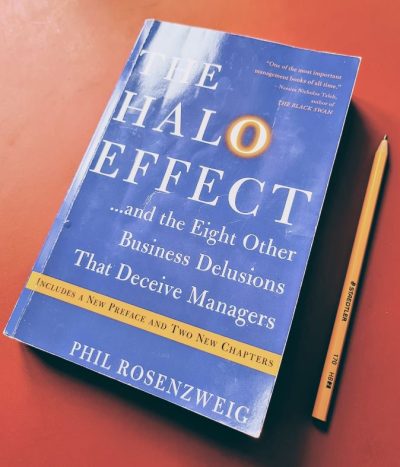The Halo Effect
...and the Eight Other Business Delusions That Deceive Managers
Author: Phil Rosenzweig
Published: 2014 (updated edition)
Buy the book here: Amazon UK
Why should I read it?
The focus is on the 9 ‘delusions’, the misconceptions that many management gurus have described over the years and which have been widely recognized and used by leaders around the world.
But it’s one thing to highlight where others are wrong. It’s another thing to come up with the answer yourself. In the final part of the book, Rosenzweig answers one of the most fundamental questions every manager and investor must ask themselves: What drives a company’s performance.
This is not an investment book, but a book for managers and investors who want to go deeper and understand which factors are ‘halos’ (good stories) and which are empirically proven.
Phil Rosenzweig
Phil Rosenzweig is a professor at the International Institute for Management Development (IMD) in Lausanne, Switzerland. Here he advises leading multinational companies on strategic and organizational decisions.
Rosenzweig has written a number of scientific articles and books, including ‘Left Brain, Right Stuff’ and ‘Accelerating International Growth’.
The halo effect and other misconceptions
The majority of the book highlights the fallacies that many leaders fall prey to in their quest for success. These misconceptions are described in a number of best-selling international management books, such as “In Search of Excellence”, “Built to Last” and “From Good to Great”. Here, the reader is led to fall into fallacies because the arguments are seemingly rational, evidence-based (extensive studies) and conducted by reputable organizations such as McKinsey. I read several of these books years ago as part of my leadership training, and I have to admit that I’ve taken the arguments to heart myself.
Here Rosenzweig has a razor-sharp ability to cut through and distinguish between what are good stories (halos/glories) and what is truly evidence-based. Here are the most important misconceptions:
- If the data we use to draw conclusions is based on our perception of success, it doesn’t matter how much data we have or how sophisticated our analytics are. Such a study is essentially a measurement of a given company’s halo, i.e. the general perception of a company.
A classic example of this is management books that highlight the characteristics of ‘great companies’ based on interviews and questionnaires from senior executives. These will inevitably be filled with halos. It is not possible to distinguish consequence and cause: do employees have high morale because they are in a successful company or is the company successful because it has satisfied employees?
- The outcome of any analysis depends on how we measure a company’s success. If the variables we use to measure are not independent of each other, it’s really just one measurement. Whether we ask for 27 characteristics of a well-known company, you’re basically asking for one metric: the overall perception of a company (its halo).
- It may be true that many successful companies focus on‘long shots‘, i.e. products and services with an expected high return and high risk. But by focusing on the most successful companies, you will only see the companies that actually made it through despite the odds. Not the 100 that turned out mediocre or didn’t survive at all (also known as survivorship bias). In many cases, the sensible choice will be to take less risk in exchange for accepting a lower return on investment.
- Success rarely lasts as long as we want it to. Competition in a capitalist society is fierce and any successful business with high returns will be a prime target for competitors. Only companies that are protected by long-term barriers (or to use Buffett’s term ‘moats’) will be able to maintain high earnings over decades. In the vast majority of cases, long-term success is a figment of our imagination – often based on post-rationalization and selection bias.
- A company’s performance is relative – not absolute. A given company can continue to improve its performance, reduce costs, etc. But if competitors are doing the same thing at a faster pace or on a larger scale, the company will still fall further and further behind.

The Mother of All Business Questions
In one of the last chapters of the book, Rosenzweig offers his own take on ultimate leadership questions: What leads to high performance? Here he tries to base his answer on empirical studies where we can see a demonstrable correlation between cause and effect. This is in contrast to the usual suspects of strong company culture, focus, etc. that can be the consequence as well as the cause of success. In answering the question, he refers to Professor Michael Porter’s basic conclusion that performance is driven by two things: strategy and execution.
Strategy does not mean a company’s goals, vision or mission. Strategy is making decisions that differentiate the company from its rivals in critical areas. Every company faces a number of basic strategic choices: Which products/services should be prioritized, how high should the price and quality be, and which markets should they be sold in? And all of these types of strategic choices involve risk. Simply because we can’t know for sure what the outcome of our choices will be.
According to Rosenzweig, there are three main reasons for this – all of which are out of the company’s control:
- Firstly, we can’t know how customers will react to a given product or its price.
- Secondly, it is difficult to predict how competitors will react, e.g. introduce a similar product, lower the price, etc.
- Thirdly, technological developments create uncertainty about how a given product/service, company or an entire sector will perform.
In addition, there are internal risks that even seasoned leaders in an organization may have difficulty anticipating: To what extent can the skills and experience of employees meet the strategic decisions – and will they even support the choices? Or work against them?
For investors, the author draws a particularly interesting conclusion, citing Jim Collins’ book “From Good to Great”. A number of the companies defined as ‘Great’ in the book are ‘dowdy’ in Collins’ view, but Rosenzweig believes they should instead be characterized as stable:
“They were less subject to radical change in technology, were less susceptible to shifts in customer demand, and may have had less intense competition. All of which meant that companies in these industries had a better chance of racking up consistent performance, year after year, than did companies in more turbulent industries.”
An effective way for investors to limit risk is to similarly choose companies in stable sectors, such as household product manufacturers (think Colgate-Palmolive or Unilever), utilities (Ørsted) or funeral homes (Service Corp International).
Execution is about turning strategic decisions into reality. Be it the way we work together, how products are produced, the way customer service is delivered, working capital management, talent development, etc. In other words, efficiently running the business as prioritized in the strategy. This is where a manager (or investor who wants to assess a management’s decisions) should ask:
“For our company, at this time, competing against our rivals, which of the many dimensions of execution are the most important? Which ones are most vital for us at this time?“
Rosenzweig’s thoughts can be summarized into five main takeaways:
- Every good strategy involves risk – that is, uncertainty about the outcome. No strategy will lead to success in all cases.
- Executing the strategy also involves risk and uncertainty of outcome. What works well in one company in one market with one specific group of employees may produce completely different results in another company.
- Luck often plays a bigger role than we think (or what successful leaders are willing to admit!).
- The link between input and output doesn’t tell the whole truth. A decision made based on a good process and executed by competent management can lead to a bad outcome. And a good result doesn’t necessarily mean that management made the right choices on the right basis.
- When the die is cast, the best leaders act as if there is only one possible outcome, with a high degree of persistence and determination.




